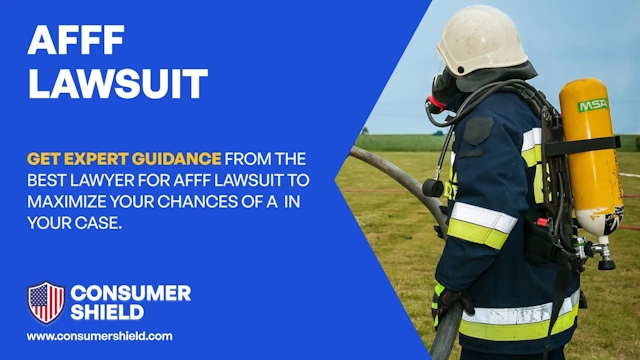
AFFF Lawsuit: Firefighting Foam Class Action (2024)
Contributor
Reviewed By Adam Ramirez, J.D.
Editor
Firefighters and safety groups across the United States are raising the alarm about Aqueous Film-Forming Foam (AFFF) – and for good reason. This substance is filled with toxic, life-altering “forever chemicals” that remain in the body indefinitely. Forever chemicals have been linked to cancers, birth defects, and other ailments, per the Environmental Working Group. Manufacturers and federal agencies – including the Department of Defense – were aware of these dangers for decades and yet did nothing to protect firefighters. Regulators added fuel to the flames by continuing to approve AFFF for firefighting operations across the nation.
Firefighters and other injured plaintiffs have the right to take legal action and ConsumerShield is here to help. Our experienced attorneys can fight for your right to compensation with confidence and efficiency.
Class-action lawsuits are currently underway, and joining this legal battle may be much easier than you realize. Taking a couple of minutes to fill out the ConsumerShield form can help you begin this process. If you have lost a loved one to suspected AFFF exposure, you are also fully within your rights to take legal action on their behalf. Reach out to us today to learn more about your legal options.
Aqueous Film-Forming Foam Lawsuit Updates
- MDL Sees Record Case Surge
- Bellwether Trials to Focus on Liver and Thyroid Cancer Cases
Free Aqueous Film-Forming Foam Lawsuit Case Review!
By clicking “SUBMIT” or providing my email address and/or phone number, I consent to be contacted by, or on behalf of, ConsumerShield or its trusted legal partners, including for marketing purposes, via the contact information I have provided. I understand that my consent is not a condition of purchasing any goods or services, and that message and data rates may apply. I have the right to opt out of text messages at any time by texting STOP. By proceeding, I also agree to ConsumerShield’s Privacy Policy, Terms of Service and Disclaimer, acknowledging that this constitutes legal advertising.
TRUSTED BY THOUSANDS OF AMERICANS NATIONWIDE |
As seen on:
What is AFFF?
AFFF is a fire suppressant that is used primarily to extinguish petroleum-based fires in military, aviation, and industrial settings. It works by spreading a thin aqueous film that rapidly cuts off the oxygen supply, suffocating the fire. Though extremely effective, AFFF has come under scrutiny as researchers continue to uncover significant health risks and environmental concerns stemming from its chemical composition.
AFFF contains per- and polyfluoroalkyl substances, commonly known as PFAS: a group of more than 9,000 synthetic chemicals that are used in both consumer and industrial products all over the world. Dubbed as “forever chemicals,” PFAS persist in the body and are linked to poor health outcomes, including cancer, increased cholesterol levels, and immune system effects.
If you were exposed to AFFF and have subsequently developed cancer or a different serious health condition, you may be eligible to pursue AFFF compensation through a lawsuit. It's crucial to stay informed about the latest developments in the AFFF lawsuit, as we continuously provide updates on AFFF lawsuit proceedings. Read on to learn more about AFFF exposure symptoms.
Understanding AFFF Exposure
Although certain workers, particularly firefighters, are more likely to come into contact with AFFF, many different types of people can be exposed to it. Exposure can occur through several routes, including the following:
- Skin contact during use
- Inhalation of aerosols
- Contaminated water sources
- Contaminated soil and environment
- Consumption of contaminated food
- Occupational exposure
PFAS does not break down easily in the environment, which is why a person can sustain AFFF exposure without ever coming into direct contact with foam.
Common AFFF Symptoms
When discussing fire fighting foam health effects, it’s important to understand that AFFF exposure has different effects on different people. The AFFF symptoms you experience depend on a number of factors, including the severity of exposure, the method of exposure, and your unique physiology.
Symptoms of AFFF exposure aren’t typically expressed right away. Most of the health effects associated with AFFF take years to manifest, which is why it’s possible to be unaware that you were exposed. Long-term symptoms may include the following:
- Increased cholesterol levels
- Changes in liver enzymes
- Increased risk of certain cancers
- Poor vaccine response
- Thyroid disease
- Ulcerative colitis
- Developmental effects in children
- Reduced fertility
Immediate or acute exposure symptoms associated with AFFF are relatively rare, as the primary danger associated with this product is PFAS. However, some people experience immediate AFFF side effects after exposure, including respiratory distress, eye and skin irritation, gastrointestinal discomfort, headaches, and dizziness.
Does AFFF Cause Cancer?
Exposure to certain PFAS—including ones contained in fire fighting foam—are linked to an increased risk of several cancers. Although not definitive, a large body of research suggests that there may be a connection between AFFF exposure the following cancers:
- Bladder cancer
- Breast cancer
- Colorectal cancer
- Liver cancer
- Testicular cancer
- Prostate cancer
- Mesothelioma
- Leukemia
Health, environmental and governmental regulatory bodies continue to conduct studies on the impact of AFFF exposure.
What is the AFFF Lawsuit?
Those who have been exposed to AFFF have the right to file an AFFF lawsuit. This type of firefighting foam saw extensive use due to its effectiveness in oil field accidents, industrial blazes, jet fuel fires and other demanding firefighting operations. With its thin, aqueous film, the foam creates a barrier that cuts off oxygen and deprives even the most raging fires of fuel.
PFAS now have an infamous reputation in the United States. “Forever chemicals” is a reference to the human body’s incapability of breaking PFAS down. Even if you lived forever, your body would spend thousands of years breaking down a single polyfluoroalkyl chain, the World Economic Forum found.
AFFF Exposure is Often Fatal
An AFFF lawsuit allows firefighters to sue if they have experienced any of these health issues due to suspected foam exposure. Unfortunately, many of these health issues prove fatal – leaving grief-stricken families struggling with unpaid medical bills, missed wages, funeral expenses, and other burdens. Whether AFFF has caused you to suffer an injury or the loss of a loved one, a lawsuit can provide compensation for everything you have been forced to endure.
Firefighters may be reluctant to sue for several reasons. You might assume that you are ineligible if your exposure occurred many years ago. While it’s true that the statute of limitations prevents plaintiffs from suing if they wait too long, this time limit probably doesn’t apply to AFFF exposure.
AFFF Statute of Limitations
The statute of limitations only applies when you become aware of your own injuries – not the moment of exposure. For example, you might receive a cancer diagnosis decades after you retired from firefighting. In this case, you would still have the right to sue if you act within the next few years after the diagnosis.
Some firefighters might also believe that it is too late, and the damage has already been done. However, a lawsuit can provide your family with valuable compensation – even if you have received a terminal diagnosis. Treatment for cancer and other health issues can be ruinously expensive, and a lawsuit may help your family deal with unpaid medical bills after your passing. If you have been unable to work due to AFFF exposure, a lawsuit may also provide your family with compensation for your lost future wages.
AFFF Manufacturers Are Most Often Sued
An AFFF lawsuit typically targets the manufacturers of this foam. Various investigations have determined that some of these manufacturers were fully aware of AFFF’s health risks, and yet they continued to market and distribute this product to fire departments across the nation. Numerous manufacturers were responsible for creating AFFF, and many lawsuits have consolidated into class actions to simplify and expedite court proceedings. A class action is a lawsuit with numerous injured parties or “plaintiffs.” With help from lawyers and organizations like ConsumerShield, these plaintiffs can work together more effectively and strive toward positive results.
Thousands of firefighters have joined forces to sue AFFF manufacturers in multi-district litigation (MDL) courts. These manufacturers include some of the biggest corporations in the United States, and many of these companies are valued at tens of billions of dollars. These organizations are fully capable of compensating injured plaintiffs, and although approaching a class action can be daunting, the rewards can be significant.
Firefighter Lawsuits & PFAS Chemicals
While AFFF has undoubtedly proven effective in combating high-intensity, fuel-based fires, the health and environmental costs associated with its use are alarming. Unraveling these dangers is crucial in understanding why AFFF lawsuits are not only necessary but urgent.
PFAS and the Environment
On the environmental front, the impact of AFFF is equally concerning. PFAS chemicals are persistent pollutants, renowned for their resistance to natural degradation processes. This means that once they're in the environment—whether through fire fighting activities, manufacturing processes, or waste disposal—they're there to stay.
These chemicals can contaminate soil, air, and crucially, water sources. The water-soluble nature of PFAS allows them to travel far from their point of origin, contaminating groundwater, rivers, and even the ocean. This widespread environmental contamination not only jeopardizes ecosystems but also exposes communities to these harmful chemicals through their drinking water—a risk that extends far beyond those directly involved in firefighting activities.
The dangers of AFFF—both health and environmental—are real and far-reaching. It's this sobering reality that underscores the importance and urgency of AFFF lawsuits. These lawsuits seek to hold the manufacturers of AFFF accountable for the harm caused by their products, providing a path to justice and compensation for those affected.
At ConsumerShield, we're committed to supporting you on this path. Our team of experts is ready to guide you through the complexities of an AFFF lawsuit, ensuring you have the best possible chance of securing the compensation you deserve. Reach out to us today.
Aqueous Film-Forming Foam Lawsuit Topics
- Settlements & Payouts
- AFFF Lawsuit Settlements & Payouts (2024)
- How to File
- How To File AFFF Lawsuit (2024)
Frequently Asked Questions
-
Aqueous Film-Forming Foam (AFFF) is a type of firefighting foam used to extinguish fuel-based fires. AFFF is dangerous because it contains Per- and Polyfluoroalkyl Substances (PFAS), a class of man-made chemicals known as "forever chemicals." These chemicals are resistant to degradation and can persist in the environment and in human bodies for a long time, leading to various health and environmental risks.
-
Exposure to PFAS chemicals in AFFF has been linked to various types of cancer, including prostate, testicular, kidney, and pancreatic cancer. Other health issues associated with PFAS exposure include immune system disorders, hormonal disruption, and endocrine-related diseases.
More Litigation
Chemical ExposureAll Aqueous Film-Forming Foam Lawsuit Topics
Chemical Exposure Litigation
Related Blog

